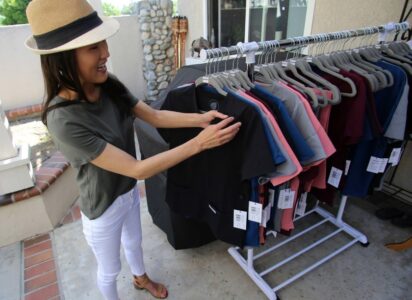How A Leukemia Diagnosis Led To Donor Awareness & A Clothing Line

There were over 414,000 people living with leukemia in the United States in 2016, according to the National Cancer Institute. This particular type of cancer is found in blood and bone marrow, meaning there is a large need for donors to support blood transfusions and marrow transplants.
It’s important to spread awareness of leukemia symptoms and the need for blood and bone marrow donors, not only during Leukemia Awareness Month, but throughout the year.
The following story outlines the experience of a 2-time cancer survivor, starting with a leukemia diagnosis that led to a campaign to increase awareness of the need for bone marrow donors in minority communities.
Leukemia Survivor Designs Scrubs To Give Back To Medical Community, Raise Awareness For Bone Marrow Registry
Source: latimes.com
Before Jenny Beeghly was diagnosed with leukemia in 2018, she was the type of person who would organize 30-day fitness challenges at work.
The Irvine-based, Korean American mother of two kept a balanced lifestyle. Yes, she’d lead her co-workers in squats, sit-ups and stair climbs, but she’d also search out delicious foods — the best pizza, pork belly, Vietnamese spring rolls or ricotta jam toast.
“One thing I was always grateful for was my health,” she says. “So [the diagnosis] came to me as a big surprise.”
She started having night sweats and thought she might have an infection or peri-menopause. When she got a call to go to the emergency room, she was on her way to a work event. She’s been in the fashion industry for over 20 years, working for brands like BCBG Max Azria, Wet Seal and Quicksilver.
She remembers telling her friends: “I have to go to the E.R. first, but I’ll see you guys there later.”
A healthy white blood cell count is about 4,000 to 11,000. Hers was 180,000. She learned she had acute lymphoblastic leukemia.
“We were just getting to the good part of life,” she says of her and her husband, who have two daughters, 8 and 14. “We got through the infant [and middle childhood] stage, I was building up my career, and I was just thinking, ‘Now we get to enjoy ourselves a little bit more.’ ”
She didn’t know anything about leukemia, but she soon found out that she needed a bone marrow transplant.
Only 30% of patients find a match within their families, and it’s more likely to find a match within one’s same racial and ethnic community.
“When I found out there aren’t that many Asians [registered], and on top of that, not many Koreans, you feel helpless,” she says, quietly.
A white patient has a 77% chance of finding a life-saving match. The numbers decrease dramatically for people of color. Native Americans have a 57% chance; Latinos, 46%; Asians or Pacific Islanders, 41%; and African Americans, 23%.
At first, there were no matches for Beeghly. But then she learned about Asians for Miracle Marrow Matches, a nonprofit organization affiliated with the Be The Match national marrow program that focuses on recruiting more donors from the Asian American community.
A leukemia diagnosis led Jenny Beeghly to encourage others to register as bone marrow donors and her experience as an acute lymphoblastic leukemia patient inspired her to launch a line of fashionable scrubs for healthcare workers. She launched the line of improved scrubs to show her gratitude to medical professionals and raise awareness of the need for more bone marrow donors from minority communities.
Become A Bone Marrow Donor
You could be a match for someone like Jenny, in need of a bone marrow transplant and help save a life. Visit Be The Match to become a bone marrow donor.
Leukemia Diagnosis?
As with other cancers, there are many types of leukemia. If you or a loved one has been recently diagnosed with leukemia, our resource library can provide you with information on a number of types of leukemia. SURVIVEiT is made up of cancer survivors, doctors and experts who want to provide you with as much support as possible during this difficult time.
If you’re feeling overwhelmed, we want to help empower you and give you hope. Start by determining what your first steps are in finding the best treatment for your specific cancer.
